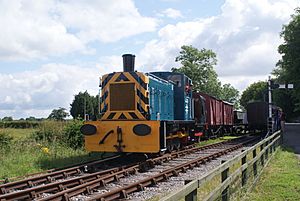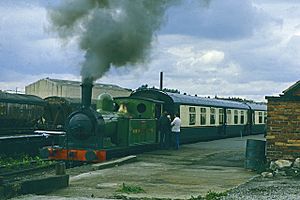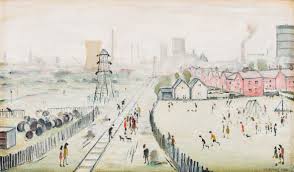Derwent Valley Light Railway facts for kids
Quick facts for kids Derwent Valley Light Railway |
|
|---|---|
| The Blackberry Line | |

A train being moved around at the Derwent Valley Light Railway.
|
|
| Locale | England |
| Terminus | Murton |
| Coordinates | 53°57′46″N 1°00′35″W / 53.9629°N 1.0096°W |
| Commercial operations | |
| Name | Derwent Valley Light Railway |
| Built by | Derwent Valley Light Railway (DVLR) |
| Original gauge | 4 ft 8 1⁄2 in (1,435 mm) standard gauge |
| Preserved operations | |
| Operated by | Derwent Valley Light Railway Society |
| Stations | 1 |
| Length | 1⁄2 mile (0.80 km) |
| Preserved gauge | 4 ft 8 1⁄2 in (1,435 mm) standard gauge |
| Commercial history | |
| Opened | 1912–1913 |
| Closed | 27 September 1981 |
| Preservation history | |
| 1985 | Light Railway Order transferred to Murton section of line |
| 1990 | Great Yorkshire Preservation Society moves to Murton |
| 1991 | Wheldrake station obtained |
| 1992 | Railway converted to Sustrans cycle track between York and Osbaldwick |
| 1993 | Railway reopens |
| 2013 | DVLR marks 100 years of original full route opening |
The Derwent Valley Light Railway (DVLR) is a historic railway in North Yorkshire, England. It is famously known as The Blackberry Line. This nickname came from the days when the trains carried fresh blackberries from farms to markets in Yorkshire and London.
The railway was special because it was always privately owned. Most other railways in Britain became part of a single, government-owned system in 1948, a process called nationalisation. But the DVLR stayed independent its whole life.
The original line ran from Layerthorpe in York to Cliffe Common. It opened over 100 years ago, in 1912 and 1913. After closing down in 1981, a small part of the line was reopened in 1993. Today, it operates as a heritage railway at the Yorkshire Museum of Farming in Murton.
Contents
The Story of the Blackberry Line
Building and Early Years
The railway was built mainly to transport goods from local farms. The first part of the line, from Wheldrake to Cliffe Common, opened on 29 October 1912. The rest of the line to York opened the next year, on 19 July 1913.
Although it was for freight, the railway also started carrying passengers in 1913. During the First World War, it was even used as a backup route for the main railway between York and Selby. However, the passenger service didn't last long and stopped in 1926.
Staying Independent
In 1923, most of Britain's railway companies were joined together into four big companies. The nearby North Eastern Railway became part of the London and North Eastern Railway. But the DVLR remained on its own.
Later, in 1948, the government took control of almost all railways in the country. This was called nationalisation, and it created British Rail. Yet again, the DVLR stayed independent, which was very unusual.
The Final Years of the Original Line
By the 1960s, the railway was much quieter. In 1964, a nearby railway line at Cliffe Common closed. This meant the DVLR lost its connection to the main network at its southern end. Because of this, the track between Wheldrake and Cliffe Common was closed in 1965. More sections of the line closed over the next few years.
By 1976, only a short section of track was left, running about 4 miles (6 km) from Layerthorpe to Dunnington. The owners decided to try running steam trains for tourists. These services ran in the summer of 1977 with a steam engine named Joem. Sadly, not enough people came to ride the trains, and they stopped in 1979.
The line carried its last freight trains to Dunnington until 1981. When the main customer there closed, the railway had no more business. The tracks and buildings were old and needed expensive repairs. The owners decided to close the railway for good. The very last train ran on 27 September 1981.
Bringing the Railway Back to Life
After the railway closed, a group of railway fans called the Great Yorkshire Railway Preservation Society wanted to save a part of it. In 1990, they moved to the Yorkshire Museum of Farming at Murton.
They started rebuilding about 3⁄4 mile (1.2 km) of the original track. They even moved the old station building from Wheldrake to create a new station at Murton. In 1993, the Derwent Valley Light Railway was reborn and opened to the public.
Today, the preserved railway runs trains on Sundays and bank holidays using a collection of historic diesel engines. A large part of the old trackbed, from York to Osbaldwick, is now a popular walking and cycling path.
The Original Route and Stations
The full railway was 16 miles (26 km) long. It stopped at these places:
- Layerthorpe (in York)
- Osbaldwick
- Murton Lane
- Dunnington Halt
- Dunnington (for Kexby)
- Elvington
- Wheldrake
- Cottingwith
- Thorganby
- Skipwith
- Cliffe Common (where it connected to another railway)
Historic Trains and Engines
Engines on the Original Railway (1913–1981)
For most of its life, the DVLR hired engines from the main railway companies. But for a short time, it owned its own vehicles.
In the 1920s, it bought two railbuses to carry passengers. These were like buses that could run on train tracks. After the passenger service ended in 1926, they were sold.
In 1969, the DVLR bought its own diesel shunter engines instead of hiring them from British Rail. One of these, number D2245, was later sold to another heritage railway but has since returned to the DVLR.
| Name/Number | Type | Notes |
|---|---|---|
| 1 Lord Wenlock | 0-6-0DM Diesel | Bought in 1969. Now preserved at the Buckinghamshire Railway Centre. |
| 2 (D2245) | 0-6-0DM Diesel | Bought in 1969. It was sold in 1978 but is now back at the DVLR. |
| Claude Thompson | 0-4-0DM Diesel | A small shunter engine used from 1978 to 1982. |
| 69023 Joem | 0-6-0T Steam | This engine pulled the tourist trains from 1977 to 1979. It is now preserved on the Wensleydale Railway. |
Trains on the Preserved Railway (1993–Present)
The preserved railway has a fantastic collection of diesel engines, carriages, and wagons. Many have been carefully restored by volunteers.
- Diesel Locomotives
The railway has several working diesel engines, including:
- 03079: A British Rail Class 03 shunter, painted in bright blue.
- D2245: A British Rail Class 04 shunter that worked on the original DVLR. It is painted in historic green.
- "British Sugar York": A green Ruston & Hornsby engine that once worked at the sugar factory in York.
- "Rowntree No.3": A green Ruston & Hornsby engine that came from the Rowntree's chocolate factory in York.
- Carriages and Wagons
The railway has a few carriages for passengers, including a historic four-wheeled coach from the North Eastern Railway. It also has a collection of goods wagons, like a brake van, a ballast wagon, and a tanker wagon, which show what the railway was originally built for.
The Railway in Art and Culture
The railway has inspired artists and musicians.
In 1952, the famous artist L. S. Lowry was asked to paint scenes of York. One of his paintings, called A View of York (from Tang Hall Bridge), shows the railway line running past some playing fields, with York Minster in the distance.
In 2013, the railway became the star of a Christmas music video. York singer Rebecca Newman filmed her version of the song Wonderful Dream (Holidays are Coming) at the DVLR. The video featured volunteers, local children, and the railway's trains. It was a big hit on YouTube.
Images for kids














